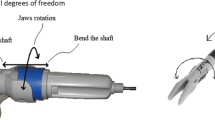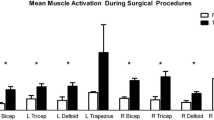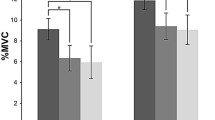Abstract
Background
Adding to the ergonomic inconveniences already presented by traditional laparoscopy (LAP), laparoendoscopic single-site (LESS) surgery has been found to entail other more specific problems, including greater reduction in movement freedom, in-line vision with loss of triangulation, and greater proximity of instruments. The objective of this study was to evaluate surgeons’ ergonomy during LESS surgery, through the study of muscular activity, wrist angle, and hand movements, and compare it with conventional laparoscopy.
Methods
The study group was composed by 14 experienced laparoscopic surgeons, all right-handed. Each one performed dissection tasks on a physical simulator through LAP and LESS approaches. For LAP, straight laparoscopic scissors and dissector were used, whilst for LESS articulating tip scissors and dissector were chosen. During both tasks, muscular activity of biceps brachii, triceps brachii, forearm flexors and extensors, and trapezius muscles was registered through surface electromyography. Simultaneously right-hand movements and wrist angles were obtained through a motion capture data glove (CyberGlove®), which allowed for the use of a modified RULA test applied to the recorded angles with subsequent establishment of risk levels for the wrist joint.
Results
Muscular activity for trapezius (LAP 6.94 ± 4.12 vs. LESS 11.32 ± 4.68; p ≤ 0.05) and forearm extensor muscles (LAP 9.2 ± 2.45 vs. LESS 37.07 ≤ 16.05; p ≤ 0.001) was significantly lower in conventional laparoscopy compared with LESS approach. No statistical significance was obtained between the different sensors, except in 3 of the 11 analyzed CyberGlove® sensors. The modified RULA test showed a score of 3 for laparoscopy (unacceptable), whereas for LESS a score of 2 was obtained (acceptable), with statistically significant differences between them (p ≤ 0.05).
Conclusions
The LESS approach entails greater level of muscular activity in the trapezius and forearm extensor muscles, but we have found evidences of a better wrist position during LESS compared with traditional laparoscopy.




Similar content being viewed by others
References
Raman JD, Bagrodia A, Cadeddu JA (2009) Single-incision, umbilical laparoscopic versus conventional laparoscopic nephrectomy: a comparison of perioperative outcomes and short-term measures of convalescence. Eur Urol 55:1198–1204
Ponsky LE, Cherullo EE, Sawyer M, Hartke D (2008) Single access site laparoscopic radical nephrectomy: initial clinical experience. J Endourol 22:663–666
Kaouk JH, Haber GP, Goel RK, Desai MM, Aron M, Rackley RR, Moore C, Gill IS (2008) Single-port laparoscopic surgery in urology: initial experience. Urology 71:3–6
Uematsu D, Akiyama G, Narita M, Magishi A (2011) Single-access laparoscopic low anterior resection with vertical suspension of the rectum. Dis Colon Rectum 54:632–637
Emami CN, Garrett D, Anselmo D, Nguyen NX (2011) Pediatric single incision laparoscopic cholecystectomy: lessons learned in the first 25 cases. Pediatr Surg Int 27:743–746
Park HS, Kim TJ, Song T, Kim MK, Lee YY, Choi CH, Lee JW, Kim BG, Bae DS (2011) Single-port access (SPA) laparoscopic surgery in gynecology: a surgeon’s experience with an initial 200 cases. Eur J Obstet Gynecol Reprod Biol 154:81–84
Gaujoux S, Kingham TP, Jarnagin WR, D’Angelica MI, Allen PJ, Fong Y (2011) Single-incision laparoscopic liver resection. Surg Endosc 25:1489–1494
Rassweiler JJ (2011) Is LESS/NOTES really more? Eur Urol 59:46–48
Warren D, Smith D, Denise L, Forkey MS, Berguer R (1998) The virtual instrumentation (VI) laboratory facilitates customized on-site ergonomic analysis of minimally invasive surgery. Med Meets Virtual Real 50:240–245
Berguer R, Chen J, Smith WD (2003) A comparison of the physical effort required for laparoscopic and open surgical techniques. Arch Surg 138:967–970
Hemal AK, Srinivas M, Charles AR (2001) Ergonomic problems associated with laparoscopy. J Endourol 15:499–503
Berguer R, Forkey DL, Smith WD (1999) Ergonomic problems associated with laparoscopic surgery. Surg Endosc 13:466–468
Berguer R, Rab GT, Abu-Ghaida H, Alarcon A, Chung J (1997) A comparison of surgeons’ posture during laparoscopic and open surgical procedures. Surg Endosc 11:139–142
Perez-Duarte FJ, Sanchez-Margallo FM, Martin-Portugues ID, Sanchez-Hurtado MA, Lucas-Hernandez M, Sanchez-Margallo JA, Uson-Gargallo J (2013) Ergonomic analysis of muscle activity in the forearm and back muscles during laparoscopic surgery: influence of previous experience and performed task. Surg Laparosc Endosc Percutan Tech 23:203–207
Perez-Duarte FJ, Sanchez-Margallo FM, Diaz-Guemes Martin-Portugues I, Sanchez-Hurtado MA, Lucas-Hernandez M, Uson Gargallo J (2012) Ergonomics in laparoscopic surgery and its importance in surgical training. Cir Esp 90:284–291
Morandeira-Rivas A, Millan-Casas L, Moreno-Sanz C, Herrero-Bogajo ML, Tenias-Burillo JM, Gimenez-Salillas L (2012) Ergonomics in laparoendoscopic single-site surgery: survey results. J Gastrointest Surg 16:2151–2159
Autorino R, Cadeddu JA, Desai MM, Gettman M, Gill IS, Kavoussi LR, Lima E, Montorsi F, Richstone L, Stolzenburg JU, Kaouk JH (2011) Reply from Authors re: Jens J. Rassweiler. Is LESS/NOTES really more? Eur Urol 59:48–50
Montero PN, Acker CE, Heniford BT, Stefanidis D (2011) Single incision laparoscopic surgery (SILS) is associated with poorer performance and increased surgeon workload compared with standard laparoscopy. Am Surg 77:73–77
Islam A, Castellvi AO, Tesfay ST, Castellvi AD, Wright AS, Scott DJ (2011) Early surgeon impressions and technical difficulty associated with laparoendoscopic single-site surgery: a Society of American Gastrointestinal and Endoscopic Surgeons learning center study. Surg Endosc 25:2597–2603
Canes D, Desai MM, Aron M, Haber GP, Goel RK, Stein RJ, Kaouk JH, Gill IS (2008) Transumbilical single-port surgery: evolution and current status. Eur Urol 54:1020–1029
Cadeddu J, Fernandez R, Desai M, Bergs R, Tracy C, Tang SJ, Rao P, Scott D (2009) Novel magnetically guided intra-abdominal camera to facilitate laparoendoscopic single-site surgery: initial human experience. Surg Endosc 23:1894–1899
Kommu SS, Rane A (2009) Devices for laparoendoscopic single-site surgery in urology. Expert Rev Med Devices 6:95–103
Autorino R, Stein RJ, Lima E, Damiano R, Khanna R, Haber GP, White MA, Kaouk JH (2010) Current status and future perspectives in laparoendoscopic single-site and natural orifice transluminal endoscopic urological surgery. Int J Urol 17:410–431
Yin G, Han WK, Faddegon S, Tan YK, Liu ZW, Olweny EO, Scott DJ, Cadeddu JA (2013) Laparoendoscopic single site (LESS) in vivo suturing using a magnetic anchoring and guidance system (MAGS) camera in a porcine model: impact on ergonomics and workload. Urology 81:80–84
Han WK, Tan YK, Olweny EO, Yin G, Liu ZW, Faddegon S, Scott DJ, Cadeddu JA (2013) Comparison between magnetic anchoring and guidance system camera-assisted laparoendoscopic single-site surgery nephrectomy and conventional laparoendoscopic single-site surgery nephrectomy in a porcine model: focus on ergonomics and workload profiles. J Endourol 27:490–496
Yun MH, Eoh H, Cho J (2002) A two-dimensional dynamic finger modeling for the analysis of repetitive finger flexion and extension. Int J Ind Ergon 29:231–248
Grinyagin IV, Biryukova EV, Maier MA (2005) Kinematic and dynamic synergies of human precision-grip movements. J Neurophysiol 94:2284–2294
Wong JPYLR, Ma L (2000) Virtual 3D sculpting. J Visual Comp Animat 11:155–166
Sánchez-Margallo F, Sánchez-Margallo J, Pagador J, Moyano J, Moreno J, Usón J (2010) Ergonomic assessment of hand movements in laparoscopic surgery using the CyberGlove®. Computational Biomechanics for Medicine. Springer, New York, pp 121–128
Tang B, Hou S, Cuschieri SA (2012) Ergonomics of and technologies for single-port laparoscopic surgery. Minim Invasive Ther Allied Technol 21:46–54
Acknowledgments
The authors are especially grateful to MISCJUs personnel for their technical assistance. This work has been partially funded by project PI12/01467 granted by the Institute of Health Carlos III-FIS of Spain.
Disclosures
Drs. F. J. Pérez-Duarte, M. Lucas-Hernández, A. Matos-Azevedo, J. A. Sánchez-Margallo, I. Díaz-Güemes, and F. M. Sánchez-Margallo have no conflict of interest or financial ties to disclose.
Author information
Authors and Affiliations
Corresponding author
Rights and permissions
About this article
Cite this article
Pérez-Duarte, F.J., Lucas-Hernández, M., Matos-Azevedo, A. et al. Objective analysis of surgeons’ ergonomy during laparoendoscopic single-site surgery through the use of surface electromyography and a motion capture data glove. Surg Endosc 28, 1314–1320 (2014). https://doi.org/10.1007/s00464-013-3334-4
Received:
Accepted:
Published:
Issue Date:
DOI: https://doi.org/10.1007/s00464-013-3334-4




